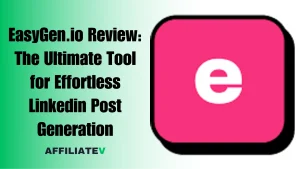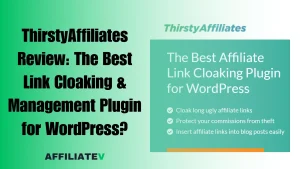ConvertKit Review – Is It the Best Email Marketing Tool for Affiliate Marketers in 2025?
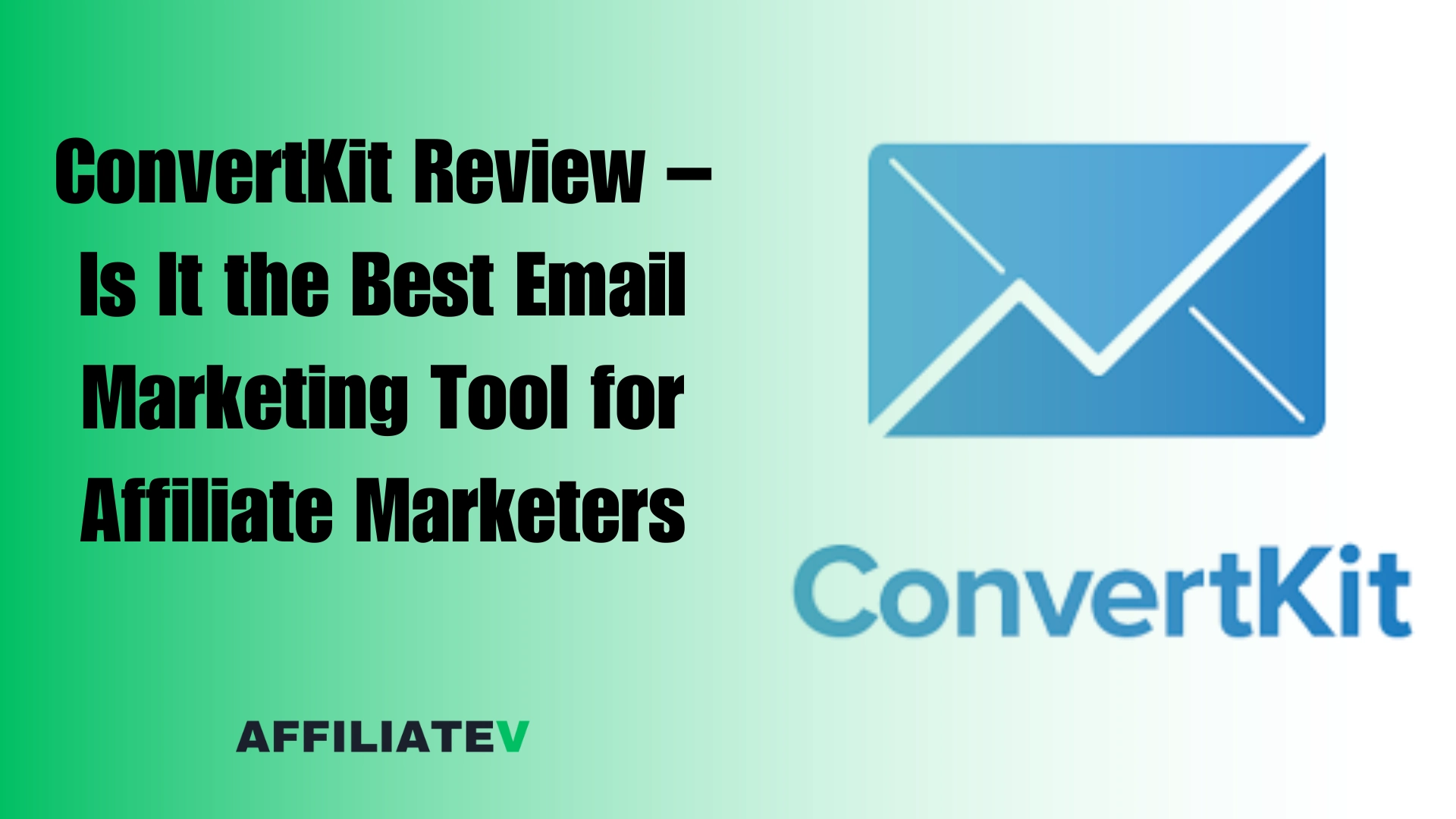
Affiliate marketing depends on one thing more than anything else—building relationships. And nothing does that better than email.
Unlike social media platforms, where algorithms dictate your reach, email gives you full control. When you own an email list, you own your audience.
That’s why picking the right email marketing tool is a big deal. The wrong platform can limit your reach, mess with your deliverability, or make automation a headache. The right one makes everything easier—growing your list, writing emails, tracking results, and increasing commissions.
I’ve worked with plenty of email marketing platforms over the years, but ConvertKit has been one of my go-to tools. It’s designed for creators, but it also offers powerful features for affiliate marketers. From building landing pages to automating email sequences, it covers the essentials without being overly complicated.
But is ConvertKit still the best option in 2025? With new competitors and changing marketing strategies, does it give affiliate marketers everything they need? That’s what this review aims to find out.
I’ll break down ConvertKit’s features, pros and cons, and how it stacks up against other tools. By the end, you’ll know if it’s the right email marketing platform for your business.
What is ConvertKit?
ConvertKit is an email marketing platform designed for creators, but it has become a strong choice for affiliate marketers. Unlike traditional email services that focus on broad business use, ConvertKit tailors its features to content creators, bloggers, and online entrepreneurs.
It simplifies email automation, segmentation, and monetization—key areas that matter for affiliates.
A lot of email marketing platforms feel devastating with unnecessary features, ConvertKit keeps things focused. It’s built to help you grow your email list, send personalized emails, and automate follow-ups without wasting time on complicated setups.
Key Features That Make ConvertKit Stand Out
These are what I like about ConvertKit.
Let me explain…
1. Tag-Based System Instead of Lists
Most email platforms rely on multiple lists, making segmentation a mess. ConvertKit uses tags instead, so you can manage subscribers in one place.
This is a big deal for affiliate marketers who promote different products. Instead of duplicating contacts across lists, you simply tag them based on interests, purchase history, or engagement level.
2. Automated Email Sequences for Passive Sales
Automation is crucial for affiliate marketing. ConvertKit makes it easy to set up email sequences that nurture leads, promote offers, and follow up based on user behavior. You can create automated sales funnels that run on autopilot, ensuring that new subscribers receive the right content without manual work.
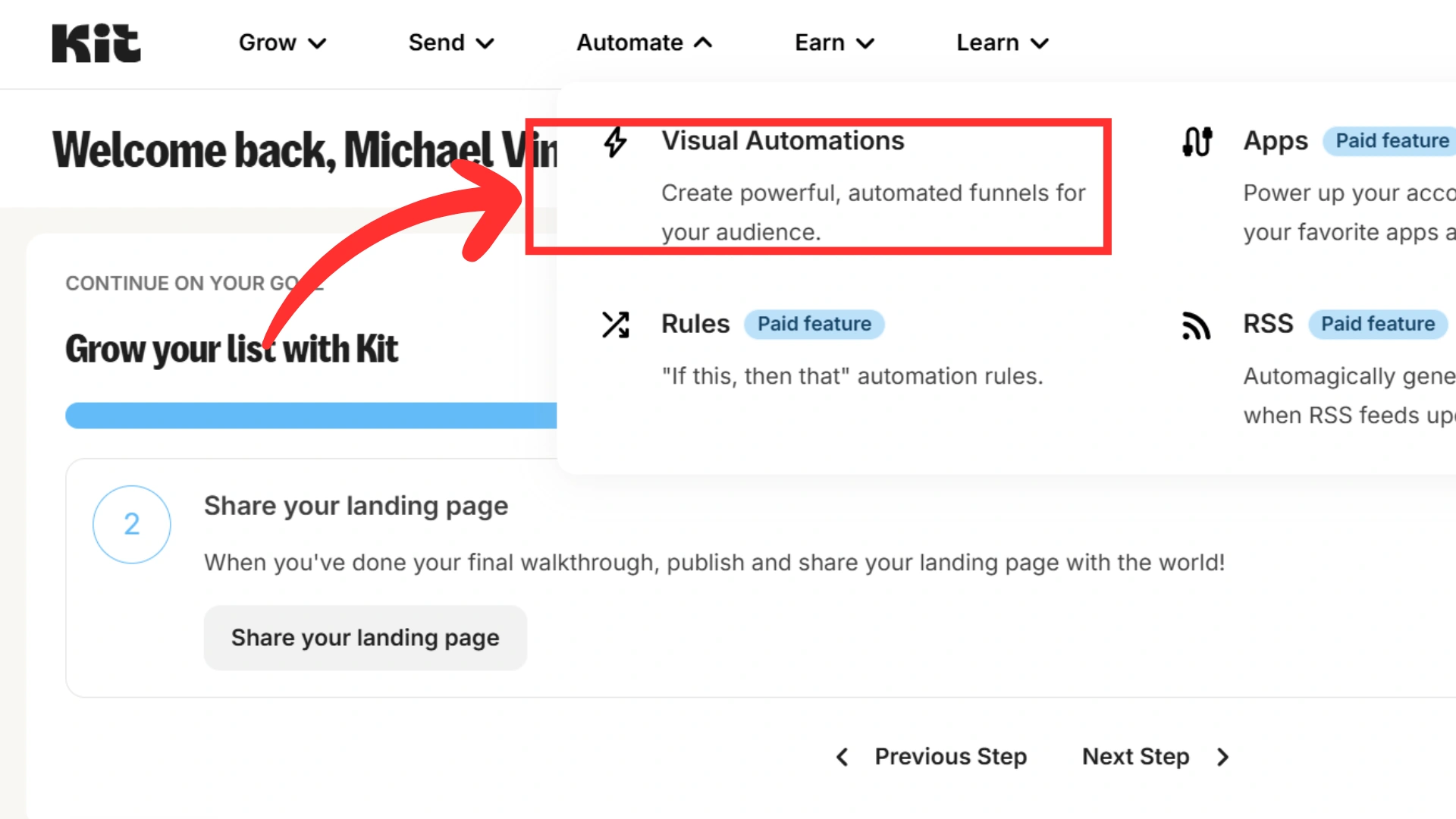
3. High Deliverability Rates
Email marketing is useless if your messages land in spam. ConvertKit has a strong reputation for high deliverability, meaning your emails are more likely to reach inboxes. They focus on clean email sending practices, which helps maintain your sender reputation and improves open rates.
4. Simple but Powerful Landing Page Builder
Most email platforms require third-party tools to create landing pages. ConvertKit includes a built-in landing page builder, making it easy to capture leads. You can customize templates, add opt-in forms, and start collecting emails without needing a separate website.
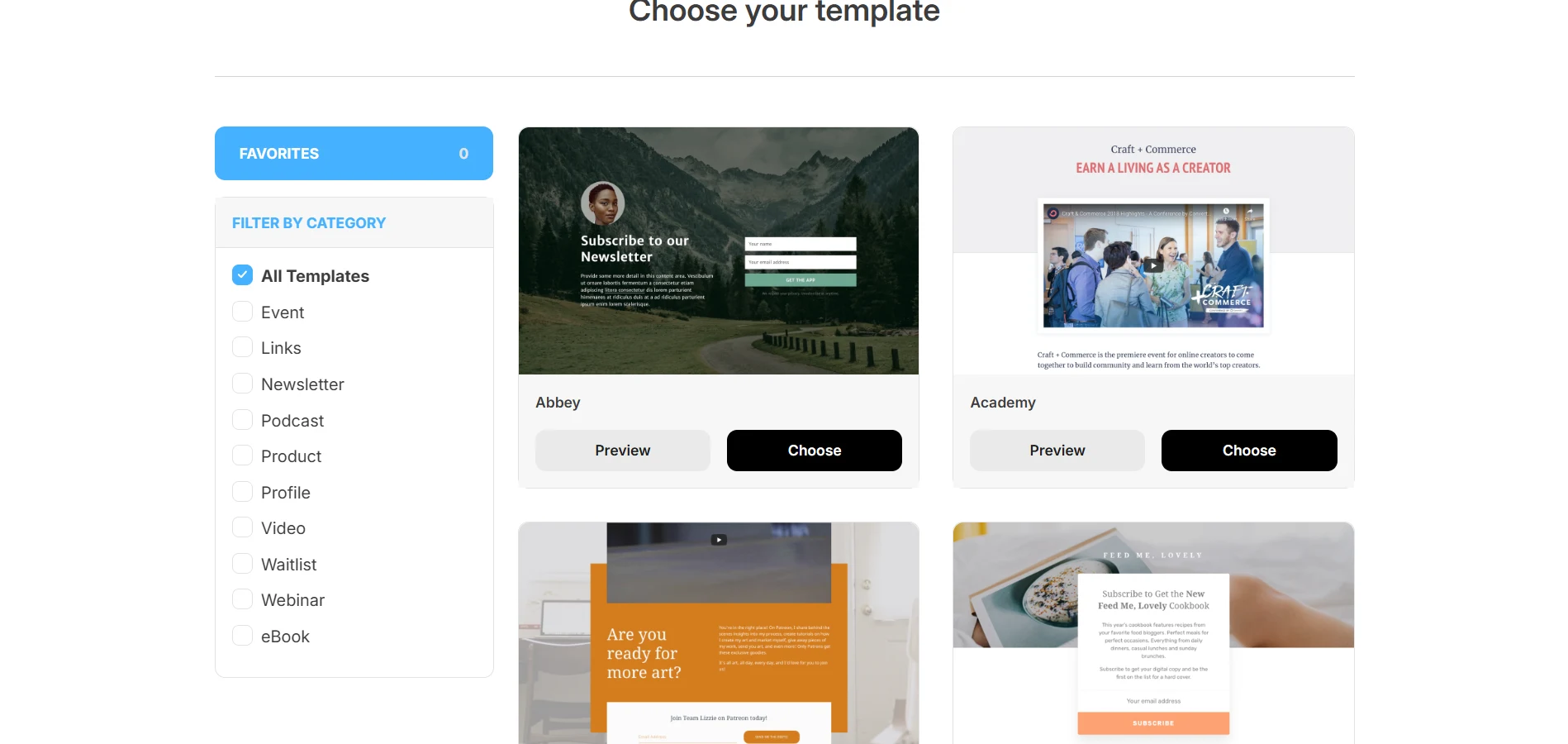
5. No Extra Charges for Duplicate Subscribers
Many email services charge for the same subscriber if they appear on multiple lists. ConvertKit avoids that by managing all subscribers under one system. This saves money, especially for affiliates who run multiple campaigns.
6. Creator-Focused Monetization Tools
ConvertKit includes features like paid newsletters and product sales, which aren’t common in other email platforms. While not directly related to affiliate marketing, these tools can provide an extra revenue stream alongside affiliate commissions.
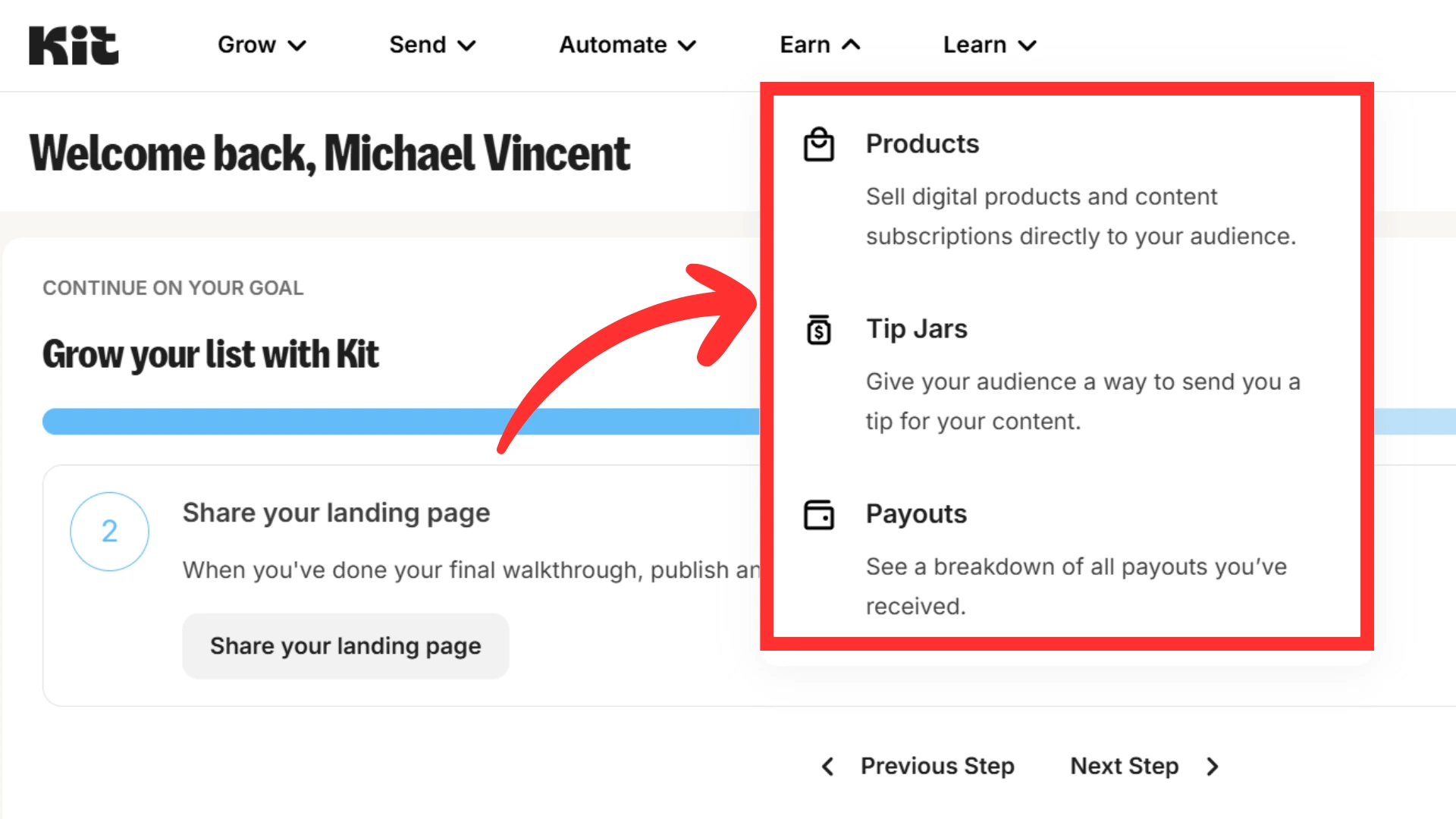
Why ConvertKit Stands Out from Other Email Marketing Tools
Compared to platforms like Mailchimp, AWeber, or GetResponse, ConvertKit focuses on ease of use and automation. While some tools offer more advanced features, they often come with a steep learning curve.
ConvertKit keeps things simple, making it perfect for affiliates who want to focus on content and conversions instead of figuring out complex software.
Why Affiliate Marketers Need a Specialized Email Marketing Tool
Affiliate marketing isn’t like selling your own products. You’re promoting different offers, targeting various audiences, and dealing with multiple commissions.
A one-size-fits-all email platform won’t cut it. You need a tool designed for automation, segmentation, and compliance to make sure your emails reach the right people and follow legal rules.
Automation: Turning Leads into Commissions on Autopilot
Most people won’t buy from a single email. They need time to trust you, see the value in your recommendations, and take action. That’s where automation comes in.
With the right email tool, you can send an automated welcome sequence that builds trust. You can recommend products based on what your subscribers engage with. And you can follow up with people who clicked a link but didn’t buy.
If you had to do this manually, you’d spend hours managing emails instead of growing your business.
Segmentation: Promoting the Right Offers to the Right People
Not all subscribers are the same. Some are beginners, others are advanced users. Some want software tools, while others are looking for training. If you send the same emails to everyone, you’ll lose engagement and potential sales.
A specialized email tool helps you tag subscribers based on their interests. It lets you separate buyers from non-buyers and adjust follow-ups. It also keeps you from promoting the same offer to people who already purchased.
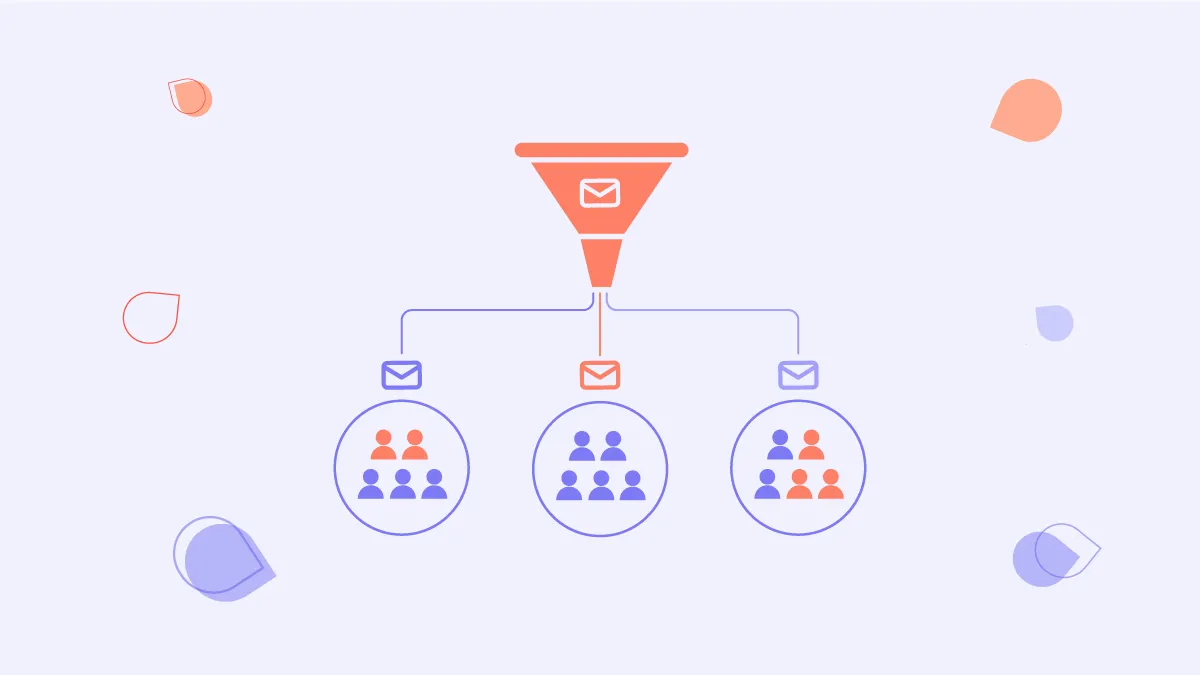
This keeps your emails relevant, increasing open rates and conversions.
Why Generic Email Tools Fall Short
Most email platforms weren’t built for affiliate marketing. They either have restrictions or lack key features.
Some platforms ban affiliate links or limit how often you can send promotional emails. Others don’t offer advanced automation, making it hard to create an effective sales funnel. And many charge for duplicate subscribers, even if they’re on different lists.
A platform designed for affiliates lets you market without these limitations.
Compliance: Avoiding Legal and Deliverability Issues
Email marketing must follow rules like CAN-SPAM (U.S.) and GDPR (Europe) to avoid penalties and prevent emails from landing in spam. A good tool helps with compliance by providing easy unsubscribe options, storing consent records, and using authentication tools to improve email deliverability.
If your email platform doesn’t handle compliance properly, your emails might never reach inboxes—or worse, you could face legal trouble.
Choosing the Right Tool Matters
Affiliate marketing needs an email platform that supports automation, segmentation, and compliance. Generic tools often fall short, while a specialized platform like ConvertKit gives you the flexibility and control needed to grow and monetize your list.
Pros and Cons of Using ConvertKit for Affiliate Marketing
No email platform is perfect, but some are better suited for affiliate marketing than others. ConvertKit has features that work well for affiliates, but there are also a few drawbacks to consider.
Pros: Why ConvertKit Works for Affiliate Marketing
1. Strong Deliverability Rates – It doesn’t matter how good your emails are if they land in spam. ConvertKit has one of the best reputations for keeping emails in inboxes. They use proper authentication methods, clean sending practices, and dedicated IPs to make sure your emails reach your audience.
2. Easy-to-Use Automation – Some email tools make automation confusing. ConvertKit keeps it simple. You can set up automated sequences to send the right emails at the right time. Whether it’s a welcome series, product recommendations, or re-engagement emails, the setup is straightforward.
3. Affiliate-Friendly Policies – Many platforms ban or restrict affiliate marketing. ConvertKit doesn’t. As long as you follow ethical practices—like avoiding spammy tactics and promoting quality products—you won’t have to worry about getting banned.
4. No Extra Charges for Duplicate Subscribers – Some platforms charge you multiple times if the same person is on different lists. ConvertKit uses a tag-based system instead of lists, so you won’t pay extra for the same subscriber.
Cons: Where ConvertKit Falls Short
1. No Visual Automation Builder – If you like dragging and dropping elements to build automation workflows, ConvertKit might feel limiting. The automation system is simple, but it’s text-based, so you don’t get a visual flowchart like in some other platforms.
2. Pricing Can Be High for Beginners – ConvertKit’s free plan is great for starting out, but once your list grows past 1,000 subscribers, the paid plans kick in. The pricing can feel steep compared to other platforms, especially if you’re not generating consistent affiliate commissions yet.
ConvertKit is one of the best email tools for affiliate marketing because of its deliverability, automation, and friendly policies. But it’s not perfect. If you need a visual automation builder or have a tight budget, you might want to explore other options.
That said, for serious affiliate marketers, the benefits often outweigh the downsides.
ConvertKit Pricing: Is It Worth the Cost?
ConvertKit offers several pricing plans tailored to different needs. Here’s a detailed breakdown to help you decide if it’s the right fit for you.
ConvertKit Pricing Plans
ConvertKit provides three main plans: Newsletter (Free), Creator, and Creator Pro. Each plan offers a range of features to accommodate various stages of your business growth.
| Plan | Cost (Monthly) | Subscriber Limit | Key Features |
|---|---|---|---|
| Newsletter | $0 | Up to 10,000 | Unlimited landing pages, opt-in forms, email broadcasts, audience tagging, sell digital products, 1 basic Visual Automation, 1 email Sequence, 1 user |
| Creator | $25 | Up to 1,000 | All Free plan features plus: Unlimited Visual Automations, unlimited email Sequences, 2 users, remove ConvertKit branding, automated funnels |
| Creator Pro | $50 | Up to 1,000 | All Creator plan features plus: Facebook custom audiences, newsletter referral system, subscriber engagement scoring, priority support, unlimited users |
Note: Prices increase as your subscriber count grows. For example, with 5,000 subscribers, the Creator plan costs $79/month, and the Creator Pro plan costs $111/month.
Free vs. Paid Plans for Affiliates
The Newsletter (Free) plan is ideal for beginners with up to 10,000 subscribers. It includes essential features like unlimited landing pages, opt-in forms, and email broadcasts. However, it lacks advanced automation capabilities, which are crucial for scaling affiliate marketing efforts. Try it free today!
Upgrading to the Creator plan unlocks unlimited visual automations and sequences, allowing for more sophisticated marketing strategies. The Creator Pro plan offers additional features like advanced analytics and priority support, beneficial for larger operations.
Pricing Comparison with Competitors
When evaluating ConvertKit’s pricing against competitors like Mailchimp and GetResponse, several factors come into play.
- Mailchimp: Offers a free plan for up to 500 subscribers. Paid plans start at $11/month for the Essentials plan, supporting up to 5,000 monthly emails to 50,000 contacts.
- GetResponse: Provides a free plan for up to 500 subscribers. Paid plans start at $15/month for the Basic plan, which includes features like email marketing, autoresponders, and unlimited landing pages.
While Mailchimp and GetResponse offer lower starting prices, ConvertKit’s free plan is more generous, allowing up to 10,000 subscribers. Additionally, ConvertKit’s focus on creators and affiliate marketers provides tailored features that might justify the higher cost for some users.
Is ConvertKit Worth the Cost?
For affiliate marketers, the value of an email marketing platform lies in its ability to automate campaigns, segment audiences, and ensure high deliverability.
ConvertKit excels in these areas, making it a strong contender despite its higher pricing tiers. However, if budget constraints are a concern, exploring other platforms like Mailchimp or GetResponse might be worthwhile.
ConvertKit vs. Competitors: How Does It Compare?
When choosing an email marketing platform, it’s essential to understand how each option stacks up, especially for affiliate marketers. Here’s a comparison of ConvertKit with some of its main competitors.
Feature Comparison
| Feature | ConvertKit | Mailchimp | ActiveCampaign | GetResponse | AWeber |
|---|---|---|---|---|---|
| Free Plan | Yes | Yes | Yes | Yes | Yes |
| Subscriber Limit (Free Plan) | Up to 1,000 | Up to 500 | Up to 500 | Up to 500 | Up to 500 |
| Automation | Basic | Basic | Advanced | Advanced | Basic |
| Landing Pages | Yes | Yes | No | Yes | Yes |
| Affiliate Marketing Friendly | Yes | Limited | Yes | Yes | Yes |
| Pricing (Starting) | $29/month | $11/month | $15/month | $15/month | $19/month |
| Deliverability Rate | High | Medium | High | High | High |
Note: Features and pricing are subject to change. Always check the official websites for the most current information.
Why ConvertKit Might Be the Best Choice for Affiliate Marketers
ConvertKit stands out for several reasons that cater specifically to affiliate marketers:
- Affiliate-Friendly Policies: Unlike some platforms that restrict affiliate marketing activities, ConvertKit supports affiliates, allowing for seamless promotion of products and services.
- User-Friendly Automation: While its automation features are basic compared to some competitors, they are intuitive and sufficient for most affiliate marketing needs, enabling personalized email sequences without a steep learning curve.
- Landing Page Integration: ConvertKit offers built-in landing pages, allowing affiliates to capture leads without relying on external tools, streamlining the marketing process.
- High Deliverability Rates: Ensuring that emails reach subscribers’ inboxes is crucial. ConvertKit is known for its high deliverability rates, which can lead to better engagement and conversion rates.
While platforms like ActiveCampaign and GetResponse offer advanced automation, they come with added complexity and cost. Mailchimp’s limitations on affiliate marketing make it less suitable for affiliates. AWeber, though similar in many respects, doesn’t offer the same level of user-friendly design as ConvertKit.
In summary, ConvertKit’s balance of affiliate-friendly policies, ease of use, and essential features make it a strong contender for affiliate marketers seeking an effective email marketing solution.
Real User Reviews and Testimonials
Truspilot Reviews
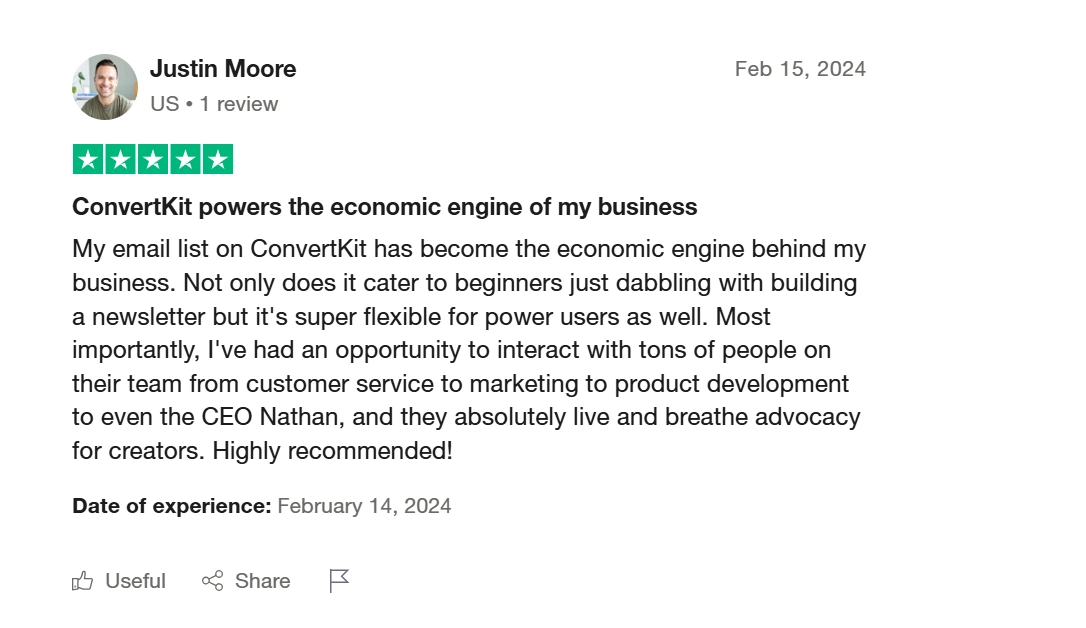
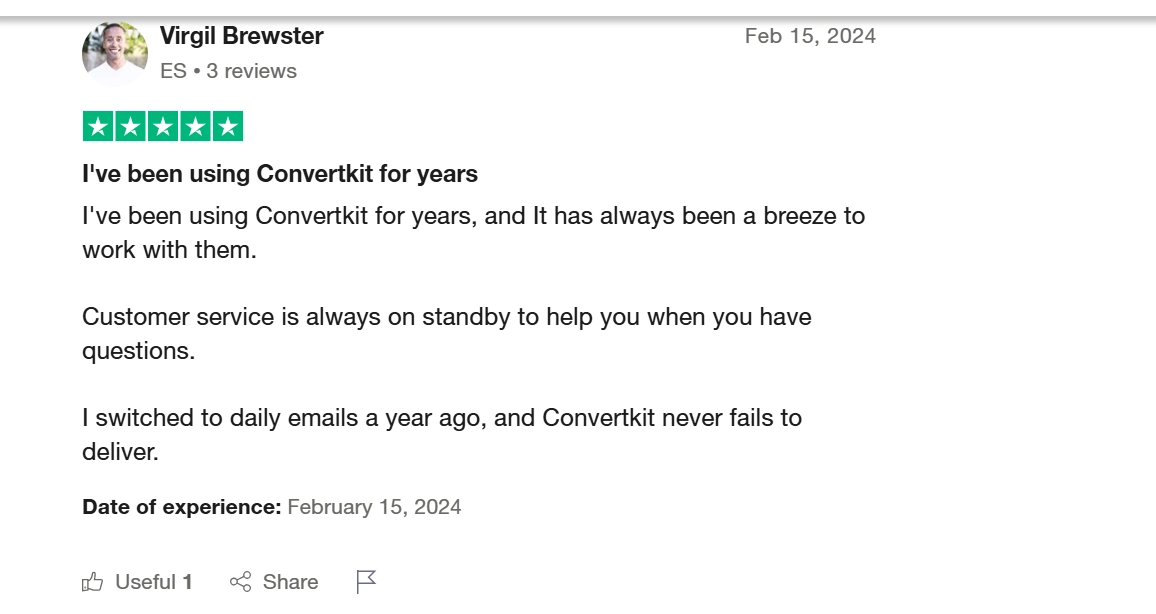
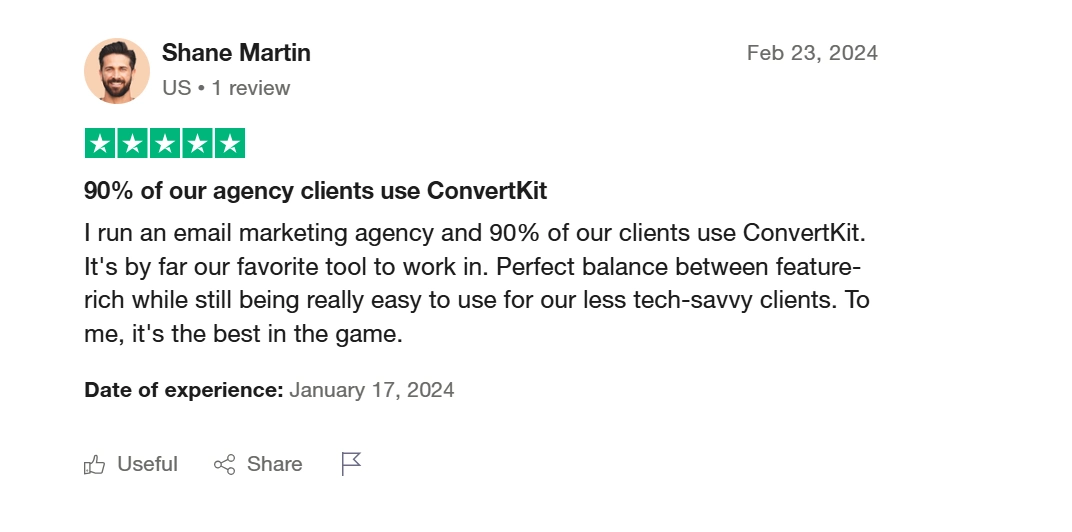
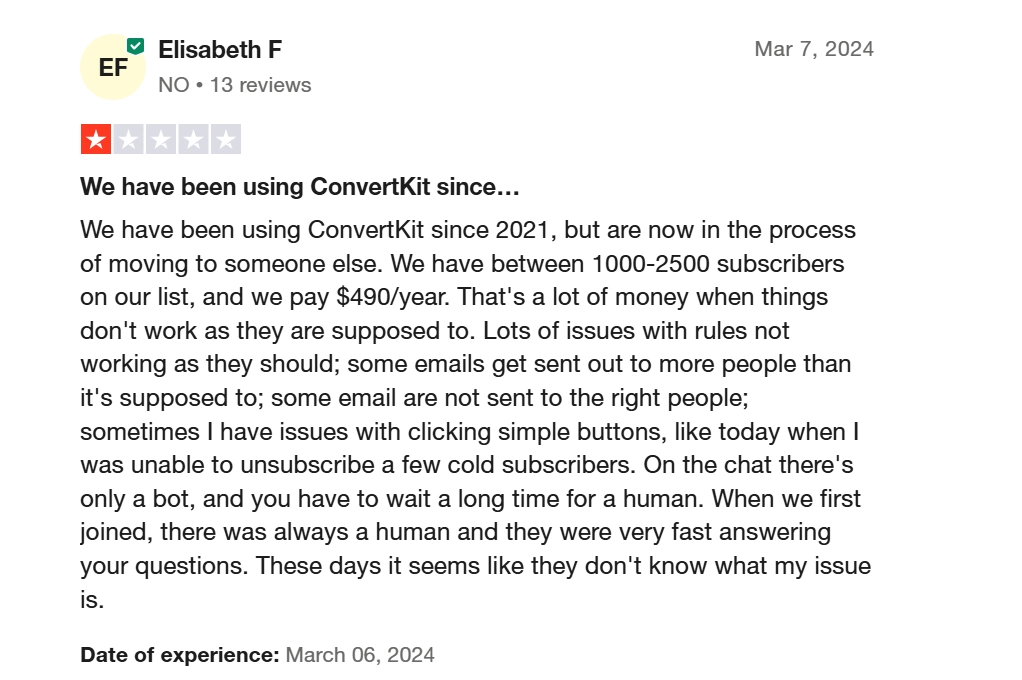
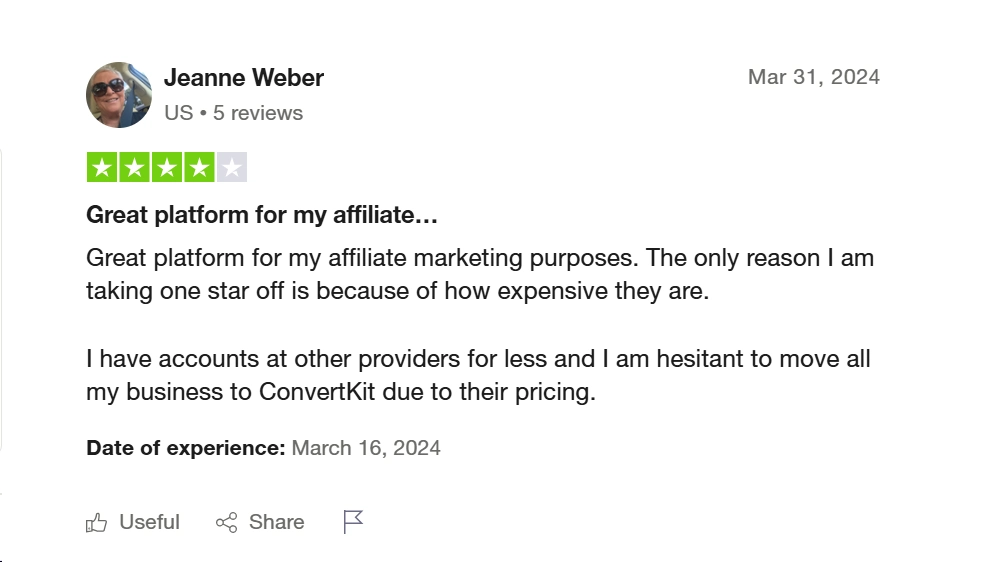
Is ConvertKit the Best Choice for Affiliate Marketers in 2025?
Email marketing plays a major role in affiliate success, and choosing the right platform can impact your results. ConvertKit stands out as a strong option, but it’s not the only choice.
Key Takeaways
ConvertKit is built for creators and affiliates, offering solid automation, high deliverability, and an affiliate-friendly approach. It supports landing pages, tags subscribers for better targeting, and allows for easy monetization.
The free plan is generous, but the paid plans can get expensive as your list grows.
Compared to competitors, ConvertKit is simpler to use than ActiveCampaign and more affiliate-friendly than Mailchimp. However, it lacks some of the advanced automation and CRM features found in higher-end tools like GetResponse.
Who Should Use ConvertKit?
ConvertKit is a great fit for affiliate marketers who focus on content marketing, email sequences, and audience engagement. If you sell digital products, run a newsletter, or want a platform that allows affiliate links without restrictions, it’s a solid choice.
Who Might Prefer Another Tool?
If you need advanced automation, a visual funnel builder, or lower-cost options, you might look at GetResponse or ActiveCampaign. If you’re running a general eCommerce store, Klaviyo may be a better fit.
Final Recommendation
ConvertKit is one of the best email marketing platforms for affiliate marketers who want ease of use, strong automation, and reliable email delivery. It’s not the cheapest option, but its focus on creators makes it a top contender.
Want to see if it works for you? Try ConvertKit’s free plan and start building your email list today.
Frequently Asked Questions
Can I use ConvertKit for affiliate marketing?
Yes, ConvertKit allows affiliate marketing. Unlike some platforms that ban affiliate links, ConvertKit lets you promote products as long as your emails provide value and aren’t just spammy sales pitches.
Does ConvertKit offer a free plan?
Yes, ConvertKit has a free plan that includes up to 1,000 subscribers, landing pages, and basic email automation. However, advanced automation, reporting, and integrations require a paid plan.
How does ConvertKit compare to Mailchimp for affiliate marketing?
Mailchimp has strict policies on affiliate links and often flags accounts for violations. ConvertKit is more affiliate-friendly, allowing link promotions without major restrictions, making it a better choice for affiliates.
What automation features does ConvertKit offer?
ConvertKit provides simple but effective automation. You can set up email sequences, segment subscribers, and trigger emails based on user actions. However, it lacks a visual automation builder, which some other platforms offer.
Is ConvertKit worth the price for affiliate marketers?
If you’re serious about building an engaged email list, ConvertKit’s features can justify the cost. It’s more expensive than some tools, but its high deliverability and ease of use make it a strong investment for long-term growth.


